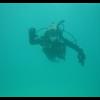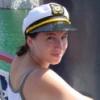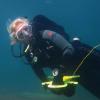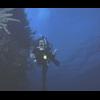Feedback is welcome; and pointing out anything you feel that she has overlooked as well as errors are welcome. She takes information from other people in pretty well. and she knows it is important to put your work before your community.
*******
Volume vs. Pressure:
A Sea-Saw
Category: Physics
by
A.Villanueva
Problem and Research
Boyleâs Law states, âFor any gas at a constant temperature, the volume of the gas will vary inversely with the pressureâ. (NOAA, 2001) In the scuba diving world, Boyleâs Law is widely known. Divers are expected to know about this Law, and you must have a clear understanding of it to get your diving certification. If divers do not know or respect this law when diving, the outcome can inflict serious injury, like an Over-Expansion Injury or Decompression Sickness (DCS).
Also referred to as the âBendsâ, Decompression Sickness (DCS), is caused when nitrogen bubbles form and get trapped in tissue. When you are ascending at the proper rate, the nitrogen starts coming back out of you, in a process divers call âoff gassing.â Then the nitrogen passes back into your bloodstream from the tissues, still in a dissolved form. The nitrogen then goes to your lungs, where you breathe it out as a gas. The longer you are under water, the more nitrogen your body absorbs. When a diver is ascending too fast, bubbles form in the blood or tissue and cause DCS.
One of the most serious diving injuries is an Over-Expansion Injury, and may be fatal. This occurs when a diver holds his or her breath and ascends. As the diver ascends, pressure decreases, and the air in the diverâs lungs expand. If the lungs expand too much, the lung sac is punctured, allowing air in between the lungs and the chest cavity. The air continues to expand, but is kept in by the chest cavity. The air then has no place to go, so it keeps expanding, forcing the lung to collapse on itself. This is life threatening. The medical terms of Over-Expansion Injuries are: âAir embolismâ, âMediastinal and Subcutaneous Emphysemaâ, and âPneumothoraxâ. Luckily enough, an Over-Expansion Injury is easy to prevent. Just breathe steadily and continuously, ascend at a controlled rate, and never hold your breath. Boyleâs Law is behind DCS, Over-Expansion Injuries, and my whole experiment.
My experiment is to visually demonstrate how pressure affects the volume of gas in a Scuba diverâs lungs. My question is: Does the volume of air decrease as pressure of the water increases, as stated in Boyleâs Law? Boyleâs Law predicts that as you descend, the pressure of the water increases, the volume of air decreases. When you ascend, the pressure of the water decreases and the volume of the air increases. This creates an inverse relationship between pressure and volume.
Hypothesis
Scuba Diving plays the main role in my 2 experiments. I dove down to 40 and 50 feet to conduct these experiments.
Experiment 1
This particular experiment showed how the amount of volume of air in a sealed bottle does not change, even at 50 feet. That is because there was no air added, so the volume of air in the bottle remained the same.
Hypothesis 1a: If pressure increases, then volume decreases.
Hypothesis 1b: If pressure decreases, then volume will increase.
Experiment 2
In this experiment, I showed how one simulated breath from a 12-year-old could expand in your lungs. In real life, this same thing would happen. If you took a breath at 40 feet, and did not breathe or let any air out, your lungs would expand tremendously, and would finally collapse in on themselves.
Hypothesis 2a: If pressure decreases, then volume will increase.
Procedure
Experiment 1
The purpose of this experiment was to show that if you go down with an empty water bottle to 50 feet, then come back up, the bottle would not explode. That is because there was be no air added, so the bottle went down with the same amount of air, and then came up with the same amount of air. The volume decreased and then expanded, but the amount of air in the bottle stayed the same.
Variables for Experiment 1
Dependent Variable: The Dependent Variable is the volume of air in the bottle.
Independent Variable: The Independent Variable is the changing depth and pressure of the water. (Volume change is a result of pressure).
Step 1: I took an empty water bottle, unscrewed the cap to let air in, and then screwed cap back on very tightly.
Step 2: I took the glue and put glue all around the bottom of the cap to seal it securely.
Step 3: Kevin E took a picture of the empty water bottle on the surface.
Step 4: Started descending down and stopped at 10 feet, and took a picture of the empty bottle.
Step 5: Stopped at 20 feet; took a picture of the empty bottle.
Step 6: Stopped at 30 feet; took a picture of the empty bottle
Step 7: Stopped at 40 feet; took a picture of the empty bottle.
Step 8: Stopped at 50 feet; took a picture of bottles.
As the bottle is descending, the bottle full of air got smaller and became more and more crushed. This was caused by the volume of air in the bottle decreasing as the pressure of the water was increasing.
Step 9: Stopped at 40 feet; took a picture of the empty bottle.
Step 10: Stopped at 30 feet; took a picture of the empty bottle.
Step 11: Stopped at 20 feet; took a picture of the empty bottle.
Step 12: Stopped at 10 feet; took a picture of the empty bottle.
Step 13: Took a picture of the bottle on the surface
As the bottle was ascending, the bottle gradually filled out to its original size and looked about the same as it did when initially starting. The bottle looked crinkly, but it wasnât as collapsed as it was at 50 feet. There was no change in the amount of air, as I went down with the same amount of air I came up with.
Experiment 2
When I did this experiment, I first practiced taking a breath and blowing the air into the balloon on the surface, to show how big the balloon looked with one of my breaths of air. I practiced this to get a rough idea how much to inflate the balloon underwater with the inflator hose. Practicing blowing the balloon up helped, because when I was underwater, I had a rough idea of what the balloon looked like with one exhale. I then just inflated the balloon as close to my visual memory as possible. Then I went down to 40 feet, took my nozzle that is attached to the low-pressure port, and inflated the balloon.
The purpose of this experiment was to show that when I inflated the balloon to about the same size as a breath from a 12 year old, as I ascended, you could be able to see how much a simulated breath from a 12 year old can expand in his or her lungs, causing serious damage to the lungs. In this case, as I ascended, you could see the volume of the air get larger as the balloon ascended towards the surface. This experiment showed Boyleâs law in reverse: as pressure decreases, volume increases.
Variables for Experiment 2
Dependent Variable: The Dependent Variable is the air in the balloon.
Independent Variable: The Independent Variable is the change of pressure. (Volume change is a result of pressure).
I took pictures and measurements at different stages of this experiment.
Step 1: Took an empty balloon and descended to 50 feet
Step 2: Inflated the balloon as close to one of my breaths as possible with the inflator nozzle, which is attached to the low-pressure port, and tied the balloon.


Step 3: Took the measuring tape and measured the circumference of the balloon at 40 feet; took picture of balloon.
Step 4: Started ascending and stopped at 30 feet and measured the circumference of the balloon. (Knowing the circumference allowed me to calculate the volume); took picture of balloon


Step 5: Stopped at 20 feet and measured the balloon; took picture of balloon.
Step 6: Stopped at 10 feet and measured the balloon; took picture of balloon.
Step 7: Measured the balloon on the surface; took picture of balloon.

As I ascended, the balloon got bigger, and based on my measurements; it showed that as I was ascending, the pressure decreased as the volume increased. This concept also is used in relation to your lungs. If you took one full breath at 40 feet and held your breath all the way to the surface, your lungs would expand, and would likely collapse. If the lungs expand too much, the lung sac is punctured, allowing air in between the lungs and the chest cavity. The air continues to expand, but is kept in by the chest cavity. The air then has no place to go, so it keeps expanding, forcing the lung to collapse on itself.
Materials
The materials I used were: Plastic water bottles, glue, balloons, measuring tape, camera, rubber nozzle attached to low pressure port, Scuba Diving Gear.
Constant
The constant for both of these experiments was the water temperature at Blue Hole, which is about 61 degrees.
Safety Section
Qualifications
I am a Junior Certified Diver. I was certified by Scuba Schools International (SSI) in the summer of 2004. (Certification card copy attached).
Experience
I have been on 24 dives. I have been diving at Blue Hole, New Mexico; Catalina Island, California; Oahu, Hawaii and Kona, Hawaii. I have also been on a night dive in Kona, Hawaii.
Dive Limitations
The reason I picked descending to 40 and 50 feet is because that is close to the depth limitation, set by certifying agencies like SSI (Scuba Schools International) and PADI (Professional Association of Diving Instructors). The generally accepted limit for children my age is 60 feet.
Supervision
My dad, Michael Villanueva, who is also a certified diver, went with me on this dive. There were three divers with me, who were supervisors. One of the safety divers was my dad. The second safety diver, Alicia E, was also a supervising safety diver. Alicia was our depth monitor, marked us off every 10 feet, and helped my dad with his buoyancy when he was helping with the balloon experiment. Alicia had to help with my dadâs buoyancy because my dad had to hold the balloon with one hand and the rope with the other hand. For my dad to try and fiddle with his buoyancy control would be too much, as the balloon wanted to pull my dad up with it! The third safety diver, Kevin E, is a certified Dive Master. Kevin supervised both experiments, and took photographs for both experiments. All of these divers are experienced, and all of us are certified divers. All divers stayed at about the same depth. Kevin E (Divemaster) monitored our safety and the experiment, and did not interfere with the experiment; he only took photographs for us.
Equipment
I have new equipment purchased this summer. My dad and I are very careful and check all equipment before every dive
Ascending Too Quickly
I have a diving computer that monitors my ascent rate and alerts me if I am ascending too fast.
Medical
I have a DAN membership (Diverâs Alert Network). If there was a medical emergency, this allows immediate helicopter assist to medical care. (Card Copy Attached)
Results
Experiment 1- The Water Bottle
The water bottle experiment went well. The bottle was easy to hold on to. The bottle gradually crushed sideways as we descended, and as we ascended, the bottle gradually filled out to its normal size. Kevin E watched over the experiment and took pictures. Alicia E was another diver that monitored our depth and marked us off every 10 feet.
1. On the surface

2. Starting to descend

3. At 30 Feet:

4. On the Surface again:

Experiment 2- The Balloon
The balloon experiment also went well. The balloon almost got away once, but luckily, it didnât. Kevin E watched over the experiment and took pictures. Alicia E helped my dad with letting air out of his BC, was the depth monitor, and marked us off every 10 feet. Underwater, I wanted to get as close as I could to inflating the balloon up to about the size of one of my breaths.
I saw a dramatic change in the amount of volume as our team ascended. The volume change was very gradual in the 40 to 20 foot range. The most visual volume change was in the 10 foot to surface range. At 10 feet, the balloon circumference was 17 inches, but on the surface, the balloon circumference was 20 inches! When I calculated the volume, the change was from about 83 to 135 cubic inches.
We only went to 40 feet because the balloon would be too hard to control if we started at 50 feet. It was hard to control even at 30 or 40 feet! The balloon was hard to control because the balloon had so much force wanting to go up to the surface. The amount of force the balloon was putting out made it very hard to control because the balloon was stretched so long along the Y-axis. The balloon was buoyant and wanted to pull my dad up with it.
4. Balloon stretched along the Y-axis:

As you can see, the balloon was stretched quite a bit, and my dad had to hold on to the balloon very tightly, just so it wouldnât get away, and he had to hold the rope tightly because the balloon wanted to pull him up!
Some things we noticed about the experiment is that it was harder to control the balloon than we thought! The water bottle experiment was easy, it wasnât hard to hold on to it or anything; it was pretty much straight forward. The balloon experiment was much harder, because the balloon was really hard to hold on to and control.
Tables 1 -3 Dive and Measurement Data

During the dives, I measured the circumference of the balloon and recorded the measurements on my slate. After the dives were completed, I used the following formulas to convert my circumference measurements into volume:
Formula for determining the Radius: R=(C/pi)/2
Formula for determining the Volume: V= (4/3) pi*r3
Tables 1, 2, and 3 show the depth, circumference, volume, % increase in volume, and overall % increase in balloon volume for the balloon experiment on each of the three dives. On the first dive, the percent change from 20 to 10 feet was 27%, but the change from 10 feet to the surface was 44%. On the second dive, the percent change from 20 to 10 feet was 20%, but the change from 10 feet to the surface was 75%! On the third dive, the percent change from 20 to 10 feet was 20%, but the change from 10 feet to the surface was 63%. I see a pattern with this data. The most percent change is not between the 30 to 20 foot range or the 20 to 10 foot range. The most percent change in volume is between the 10 to surface range. In the tables above, this is clearly shown.
Table 4 Balloon Volume in Cubic Inches by Depth by Dive

Table 4 shows what the balloon volume was at each depth. Each line is a different dive. Dive 1, the blue line, shows that from 20 to 10 feet, there was a 27% change in volume. From 10 feet to the surface, there was about a 44% change in volume. Dives 2 and 3, the red and yellow lines, pretty much follow each other. It looks like both lines have about the same amount of change from 30 feet to the surface. Again, I see the same pattern: The increase was pretty gradual from 40 feet all the way up to 10 feet, but the 10 foot to surface range is really where volume of gas expands the most.
Table 5 Percent Change by Depth

Table 5 shows the percent change of volume between depths. The graph is read like this: from 30 feet to 20 feet, there was a 10% increase in volume. From 20 feet to 10 feet, there was a 20% increase in volume. From 10 feet to the surface, there was a 75% increase in volume. The most increase in volume is not from 30 feet to 20 feet, or even from 20 feet to 10 feet. The most increase in volume is from 10 feet to the surface. This graph only represents the second dive because this dive had the most consistent information.
Conclusions
My experiment shows that pressure does affect the volume of gas in a diverâs lungs. (Represented by a balloon and a water bottle). This means that pressure does affect the volume of gas inside your lungs and could cause an Over-Expansion Injury. Overall, I see the same pattern in each of the tables. The data demonstrates that the biggest increase in volume is between the 10 feet to surface range. The overall volume percentage change is what really amazes me. On the first dive, from 20 feet to the surface, the overall percent change was 83%. On the second dive, from 30 feet to the surface, the overall percent change was 231%. On the third dive, from 40 feet to the surface, the overall percent change was 291%. As you can see, your lungs are at serious risk when you hold your breath. In fact, you can die from this. Table 5 shows how destructive volume can be on your lungs. The volume proportional change from 30 to 20 feet is 10%. From 20 to 10 feet, the change was 20%. From 10 feet to the surface, the change was 75%! Once again, this data shows that the most volume change occurs in the 10 foot to surface range. This data also gives you an idea how destructive the amount of volume in your lungs can be.
The water bottle experiment went well. The water bottle gradually got crushed as we descended to 50 feet. When we ascended back to the surface, the water bottle gradually filled out to its normal size. This confirms my hypothesis. Pressure does affect the volume of gas in a diverâs lungs. As the diver goes down, the volume of air decreases, and when they come back up, the volume increases to the original volume in the lung. Therefore there is no harm and is not dangerous to the human body. This is why free divers can take a breath on the surface, dive down to 400 or 500 feet, and come back up to the surface without there being any damage to their lungs.
When we did the balloon experiment, it went differently than we expected. We expected the balloon to get bigger in circumference. The balloon did, but it also demonstrated an enormous amount of force along the Y-axis. The balloon had so much force wanting to get up to the surface; some of our measurements may have not been completely accurate. You could really see the force of the balloon stretching towards the surface. The balloon looked more teardrop shaped than a perfect sphere. There are some things that might have affected our data. They are: The temperature of the water, and/or our measurements were a bit off.
In the beginning, when I began to study Boyleâs law, I learned about the sea saw (or inverse) relationship between volume and pressure: As pressure of the water increase, the volume of gas decreases, and as the pressure of water decreases, the volume of gas increases. I made the assumption that the percentage of volume increasing and decreasing would be a gradual change. I discovered that I was wrong. The percentage of volume increasing and decreasing is not a gradual change. In fact, the most change in the percentage of volume is within the 10 foot to surface range.
Recommendations
Because of this fact, I have some recommendations:
1. Normally, scuba buoyancy training is done in the 25 to 30 foot range. My recommendation, based on my data, is to do buoyancy training in the 10 to 0 foot range. This is because the most change in volume occurs here, so it would be worthwhile to train in the range that is the hardest to control your buoyancy.
2. It is important, when you are ascending, not to hold your breath between the 10 and 0 feet range because that is where the greatest change in air volume occurs. My recommendation is donât hold your breath!
Acknowledgments
I would like to thank the following people for helping me with my science project:
Michael A***
For reviewing my project and explaining the difference between independent and dependant variables. And for saying what a Constant variable is.
Kevin E*** (Divemaster, safety diver)
For being main safety monitor, and taking photographs.
Alicia E*** (Safety Diver)
For being our depth monitor, helping my dad with his BC, and marking us off every 10 feet.
Eileen M***
For getting and sending me the inflator hose that attaches to the low-pressure port, and
for reviewing my science project. Eileen also volunteered to be a safety diver.
Walter W***
For reviewing my project and suggesting taking added safety precautions, like using the inflator hose instead me blowing up the balloon with my mouth at depth. Also, Walter helped with the mathematical aspect of this, like telling me we needed to figure out the volume and helping out with the equations to figuring out the radius and the volume.
Michael V*** (Safety Diver)
For reviewing my project, diving assistance, technical advisor on diving, diving supervisor, and helping me make the graphs and for helping me format my paper.
Jamie V***
For helping with the math that is involved in this experiment, and helping envision where things could go on the layout.
A Special Thanks To New Mexico Scuba Center-
Stacey and Cy Minton (Owners)
For supplying my dad and I with free tanks, weights, and wetsuits.
Forrest Darst
For organizing and providing the dive team, and invaluable advice.
Bibliography
Scuba Schools International. Open Water Diver Manual. Concept Systems, Inc., 2002.
Bove, Alfred A., ed. Bove and Davisâ Diving Medicine, 4th edition. Philadelphia:
Saunders, 2004.
Brubakk, Alf O. Tom S. Neuman, eds. Bennett and Elliottâs Physiology and Medicine of Diving, 5th edition. Cornwall: MPG Books Ltd, 2003.
Bookspan, Jolie. Diving Physiology in Plain English. Kensington: Undersea And Hyperbaric Medical Society, Inc., 2003.
U.S. Department of Commerce, National Oceanic and Atmospheric Administration. NOAA Diving Manual: Diving for Science and Technology, 4th edition. Flagstaff: Best Publishing Company, 2001.
Edited by mvillanueva, 01 February 2005 - 06:32 PM.


























